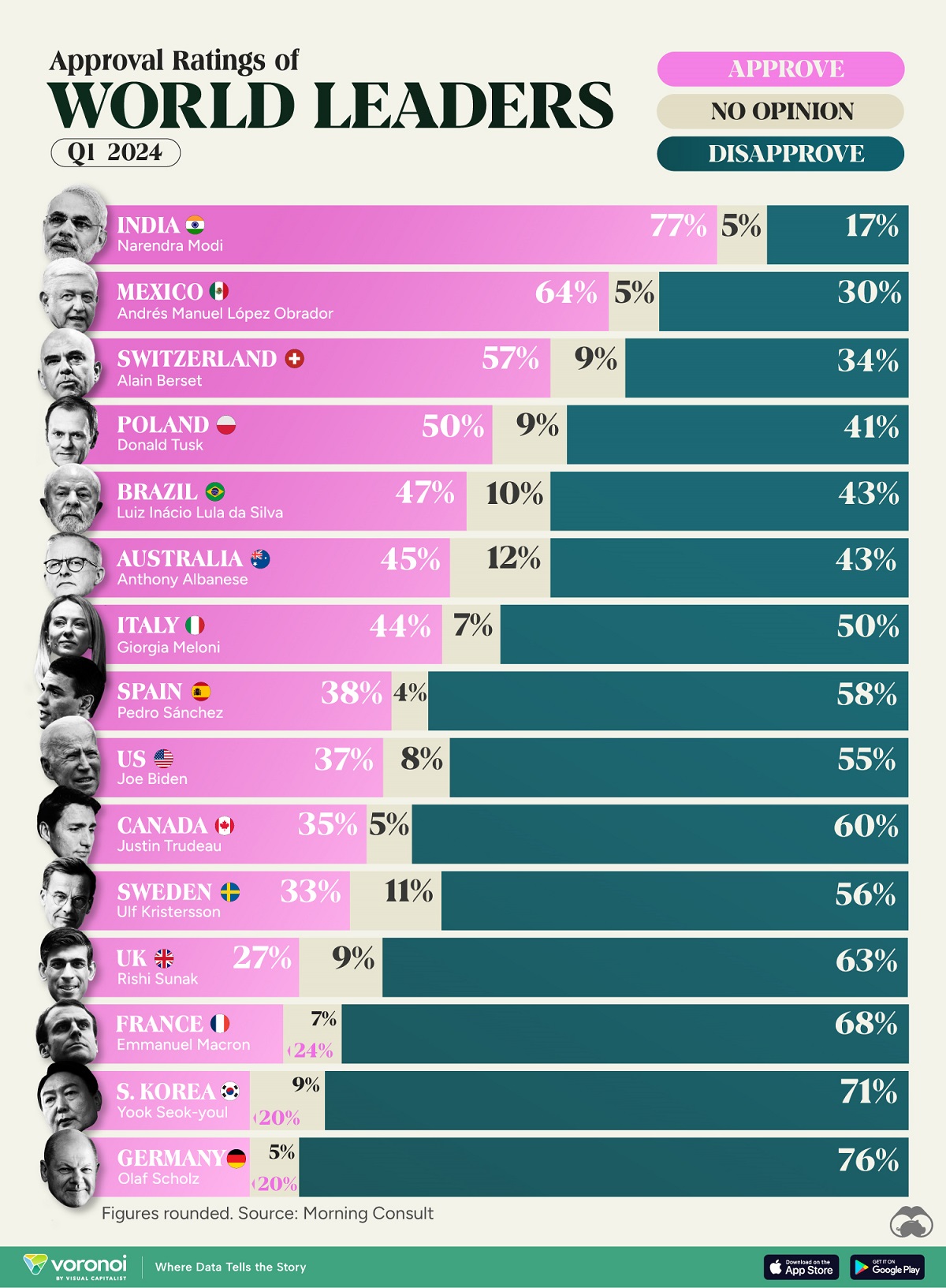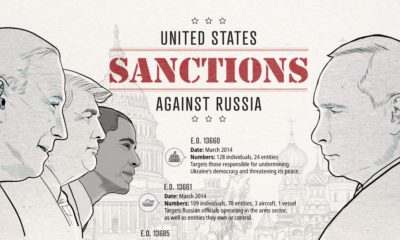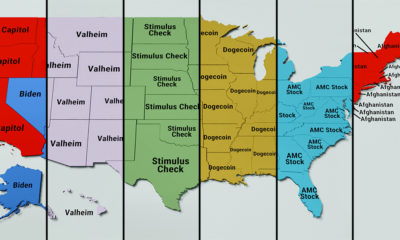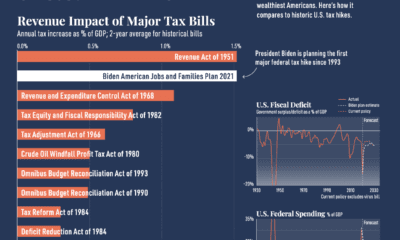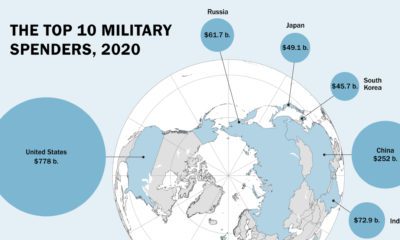Politics
Charted: The Approval Ratings of World Leaders in 2024
![]() See this visualization first on the Voronoi app.
See this visualization first on the Voronoi app.
The Approval Ratings of World Leaders in 2024
This was originally posted on our Voronoi app. Download the app for free on iOS or Android and discover incredible data-driven charts from a variety of trusted sources.
What are the approval ratings of world leaders in 2024? Morning Consult set out to answer the question, surveying people from 15 major countries around the world.
Figures in the dataset are rounded for simplicity. Data was collected from December 13, 2023 to January 2, 2024. Approval ratings are based on a seven-day moving average of adult residents in each country, with sample sizes varying by country.
Which World Leader has the Highest Approval Rating?
As of January 2024, India’s Narendra Modi has the highest percentage of domestic approval, with over two-thirds of Indians approving of his performance.
This is no recent development, as Modi’s popularity has been consistently high for years now.
| Leader | Country | Approve | Don't know / No opinion | Disapprove |
|---|---|---|---|---|
| Narendra Modi | 🇮🇳 India | 77% | 5% | 17% |
| Andrés Manuel López Obrador | 🇲🇽 Mexico | 64% | 5% | 30% |
| Alain Berset | 🇨🇭 Switzerland | 57% | 9% | 34% |
| Donald Tusk | 🇵🇱 Poland | 50% | 9% | 41% |
| Luiz Inácio Lula da Silva | 🇧🇷 Brazil | 47% | 10% | 43% |
| Anthony Albanese | 🇦🇺 Australia | 45% | 12% | 43% |
| Giorgia Meloni | 🇮🇹 Italy | 44% | 7% | 50% |
| Pedro Sánchez | 🇪🇸 Spain | 38% | 4% | 58% |
| Joe Biden | 🇺🇸 United States | 37% | 8% | 55% |
| Justin Trudeau | 🇨🇦 Canada | 35% | 5% | 60% |
| Ulf Kristersson | 🇸🇪 Sweden | 33% | 11% | 56% |
| Rishi Sunak | 🇬🇧 United Kingdom | 27% | 9% | 63% |
| Emmanuel Macron | 🇫🇷 France | 24% | 7% | 68% |
| Yook Seok-youl | 🇰🇷 South Korea | 20% | 9% | 71% |
| Olaf Scholz | 🇩🇪 Germany | 20% | 5% | 76% |
There were six total world leaders that had the plurality of respondents approve of their performance, including Mexico’s president Andrés Manuel López Obrador (AMLO) and Brazil’s Luiz Inácio Lula da Silva. One of the newest leaders, Poland’s Donald Tusk, also came in strong with 50% approval.
Eight countries had heads of state or government with disapproval ratings above 50%, including U.S. President Joe Biden and Canadian Prime Minster Justin Trudeau.
Germany’s Olaf Scholz also finds himself on the low end of the list. Scholz—who succeeded Angela Merkel in 2021—hit a record low in polling at the end of 2023 with 20% approval, tied only with South Korea’s Yook Seok-youl.
And according to Morning Consult, they weren’t the world leaders with the lowest approval ratings. The full dataset of 21 countries shows that the leaders of Japan and the Czech Republic had lower total approval ratings as of the start of 2024.
Economy
The Bloc Effect: International Trade with Geopolitical Allies on the Rise
Rising geopolitical tensions are shaping the future of international trade, but what is the effect on trading among G7 and BRICS countries?

The Bloc Effect: International Trade with Allies on the Rise
International trade has become increasingly fragmented over the last five years as countries have shifted to trading more with their geopolitical allies.
This graphic from The Hinrich Foundation, the first in a three-part series covering the future of trade, provides visual context to the growing divide in trade in G7 and pre-expansion BRICS countries, which are used as proxies for geopolitical blocs.
Trade Shifts in G7 and BRICS Countries
This analysis uses IMF data to examine differences in shares of exports within and between trading blocs from 2018 to 2023. For example, we looked at the percentage of China’s exports with other BRICS members as well as with G7 members to see how these proportions shifted in percentage points (pp) over time.
Countries traded nearly $270 billion more with allies in 2023 compared to 2018. This shift came at the expense of trade with rival blocs, which saw a decline of $314 billion.
Country Change in Exports Within Bloc (pp) Change in Exports With Other Bloc (pp)
🇮🇳 India 0.0 3.9
🇷🇺 Russia 0.7 -3.8
🇮🇹 Italy 0.8 -0.7
🇨🇦 Canada 0.9 -0.7
🇫🇷 France 1.0 -1.1
🇪🇺 EU 1.1 -1.5
🇩🇪 Germany 1.4 -2.1
🇿🇦 South Africa 1.5 1.5
🇺🇸 U.S. 1.6 -0.4
🇯🇵 Japan 2.0 -1.7
🇨🇳 China 2.1 -5.2
🇧🇷 Brazil 3.7 -3.3
🇬🇧 UK 10.2 0.5
All shifts reported are in percentage points. For example, the EU saw its share of exports to G7 countries rise from 74.3% in 2018 to 75.4% in 2023, which equates to a 1.1 percentage point increase.
The UK saw the largest uptick in trading with other countries within the G7 (+10.2 percentage points), namely the EU, as the post-Brexit trade slump to the region recovered.
Meanwhile, the U.S.-China trade dispute caused China’s share of exports to the G7 to fall by 5.2 percentage points from 2018 to 2023, the largest decline in our sample set. In fact, partly as a result of the conflict, the U.S. has by far the highest number of harmful tariffs in place.
The Russia-Ukraine War and ensuing sanctions by the West contributed to Russia’s share of exports to the G7 falling by 3.8 percentage points over the same timeframe.
India, South Africa, and the UK bucked the trend and continued to witness advances in exports with the opposing bloc.
Average Trade Shifts of G7 and BRICS Blocs
Though results varied significantly on a country-by-country basis, the broader trend towards favoring geopolitical allies in international trade is clear.
Bloc Change in Exports Within Bloc (pp) Change in Exports With Other Bloc (pp)
Average 2.1 -1.1
BRICS 1.6 -1.4
G7 incl. EU 2.4 -1.0
Overall, BRICS countries saw a larger shift away from exports with the other bloc, while for G7 countries the shift within their own bloc was more pronounced. This implies that though BRICS countries are trading less with the G7, they are relying more on trade partners outside their bloc to make up for the lost G7 share.
A Global Shift in International Trade and Geopolitical Proximity
The movement towards strengthening trade relations based on geopolitical proximity is a global trend.
The United Nations categorizes countries along a scale of geopolitical proximity based on UN voting records.
According to the organization’s analysis, international trade between geopolitically close countries rose from the first quarter of 2022 (when Russia first invaded Ukraine) to the third quarter of 2023 by over 6%. Conversely, trade with geopolitically distant countries declined.
The second piece in this series will explore China’s gradual move away from using the U.S. dollar in trade settlements.

Visit the Hinrich Foundation to learn more about the future of geopolitical trade

-

 Economy3 days ago
Economy3 days agoEconomic Growth Forecasts for G7 and BRICS Countries in 2024
The IMF has released its economic growth forecasts for 2024. How do the G7 and BRICS countries compare?
-

 United States2 weeks ago
United States2 weeks agoRanked: The Largest U.S. Corporations by Number of Employees
We visualized the top U.S. companies by employees, revealing the massive scale of retailers like Walmart, Target, and Home Depot.
-

 Economy2 weeks ago
Economy2 weeks agoWhere U.S. Inflation Hit the Hardest in March 2024
We visualized product categories that saw the highest % increase in price due to U.S. inflation as of March 2024.
-

 Economy1 month ago
Economy1 month agoG20 Inflation Rates: Feb 2024 vs COVID Peak
We visualize inflation rates across G20 countries as of Feb 2024, in the context of their COVID-19 pandemic peak.
-

 Economy1 month ago
Economy1 month agoMapped: Unemployment Claims by State
This visual heatmap of unemployment claims by state highlights New York, California, and Alaska leading the country by a wide margin.
-

 Economy2 months ago
Economy2 months agoConfidence in the Global Economy, by Country
Will the global economy be stronger in 2024 than in 2023?
-

 Debt1 week ago
Debt1 week agoHow Debt-to-GDP Ratios Have Changed Since 2000
-

 Demographics2 weeks ago
Demographics2 weeks agoPopulation Projections: The World’s 6 Largest Countries in 2075
-

 Markets2 weeks ago
Markets2 weeks agoThe Top 10 States by Real GDP Growth in 2023
-

 Demographics2 weeks ago
Demographics2 weeks agoThe Smallest Gender Wage Gaps in OECD Countries
-

 Economy2 weeks ago
Economy2 weeks agoWhere U.S. Inflation Hit the Hardest in March 2024
-

 Green2 weeks ago
Green2 weeks agoTop Countries By Forest Growth Since 2001
-

 United States2 weeks ago
United States2 weeks agoRanked: The Largest U.S. Corporations by Number of Employees
-

 Maps2 weeks ago
Maps2 weeks agoThe Largest Earthquakes in the New York Area (1970-2024)

